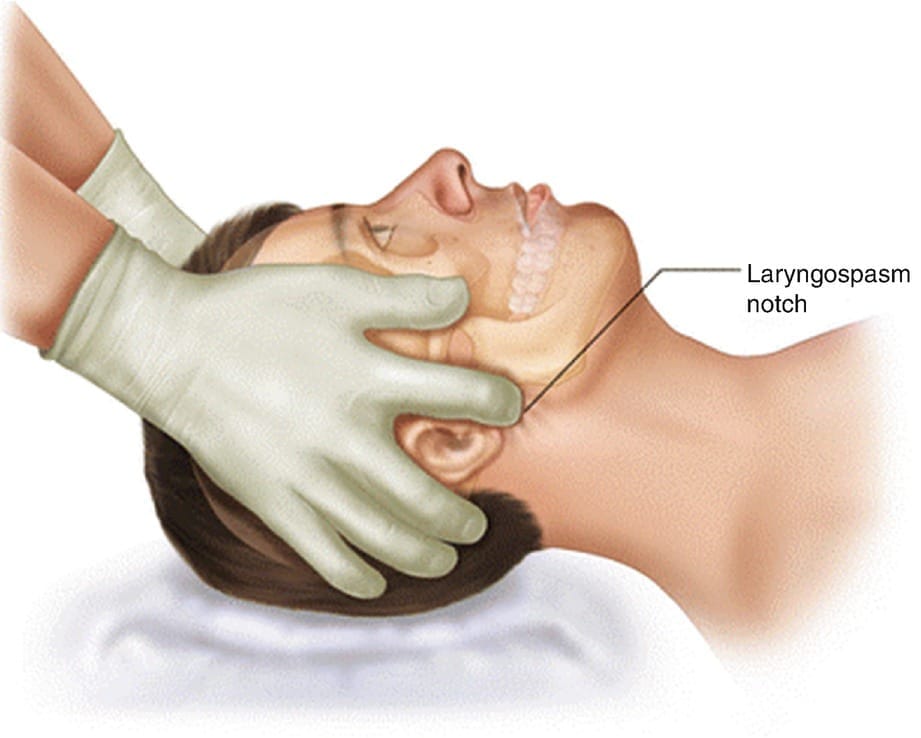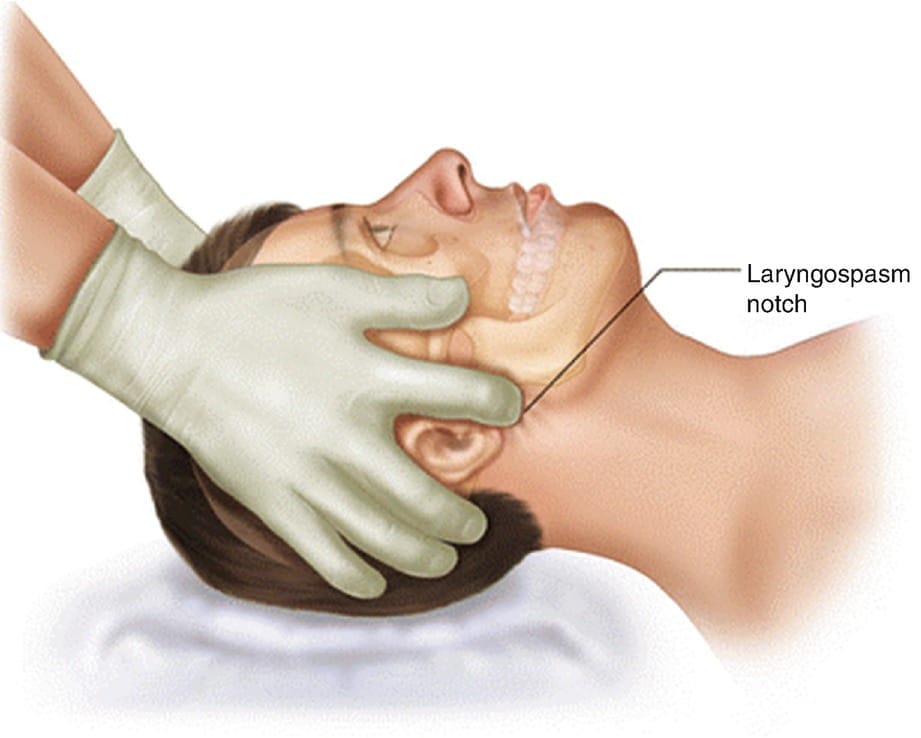Laryngospasm

If your patient is in laryngospasm right now
- Make sure the rest of the team know, and call for help as required
- 100% oxygen
- Jaw thrust
- Apply PEEP
- Larson's manoeuvre
- Pause
- Propofol 0.25-0.8 mg/kg
- Suxamethonium 0.1mg/kg IV or 4mg/kg IM through the floor of the mouth into the base of the tongue
- Monitor/Re-intubate/Front of neck/change scrub trousers if required
- Breathe (everyone involved)
While an immense compliment, in future please don't open up anaestheasier.com during a critical incident - use the QRH instead.
Take home messages
- Laryngospasm is common, preventable and treatable
- It's also potentially life-threatening
- Leave the airway alone during emergence
Podcast episode
What is it?
Our favourite guardians of the glottis - the vocal cords - hold the keys to the most sensitive reflex of the human body, the cough reflex.
It is not hard to see how this evolved to become so effective, as it is the most immediately life-saving function the body has.
When tickled, touched or troubled, the tetchy twosome trigger and slam shut to protect the trachea and respiratory tree below, which is of mixed benefit depending on the situation.
- Piece of food attempting to go cave diving - good
- Anaesthetist trying to remove ET tube - bad
Unsurprisingly, laryngospasm is most frequently encountered during airway manipulation, usually extubation, when the patient is spending a longer period of time in a shallower plane of anaesthesia.
What does it look like?
The patient is trying to breathe with a closed glottis, and depending on how closed, the signs and symptoms may include:
- Stridor (or silence)
- See-saw breathing
- Suprasternal, intercostal and subcostal recession
- Hypoxia
- Cyanosis
- Increasing distress
- Loss of ETCO2 trace
- High ventilatory pressures (if using a supraglottic airway)
Clearly if you've got the above with a well-sited endotracheal tube, it's time to start thinking of other diagnoses.
What is the differential diagnosis for laryngospasm?
- Bronchospasm
- Extrinsic (supraglottic) airway obstruction
- Foreign body aspiration
- Laryngeal oedema
- Vocal cord palsy
- Tracheomalacia
- Tracheal collapse
- Dysfunctional breathing
What can we do about it?
Prevent it
Things to do routinely:
- Propofol induction
- Thorough suctioning of blood and secretions prior to extubation
- Leave the airway well alone while patient waking up
Other things to consider:
- IV lidocaine up to 2mg/kg 2 minutes before extubation
- Magnesium sulphate 15mg/kg prior to extubation
- Atropine to reduce secretions
- Topical lidocaine to vocal cords
- Intra-cuff lidocaine
Avoiding gas induction is given as a way of preventing laryngospasm, but you're probably not going to not do a gas induction because of this.
Expect it
- Have the facemask ready
- Be able to reach the APL valve to apply PEEP
- Have spare propofol drawn up
- Know where the IM sux is (hopefully in the fridge)
- Know where the QRH is (I put it on the fridge)
- Know where your boss is
Treat it
- 100% oxygen
- Jaw thrust
- Apply PEEP
- Larson's manoeuvre
- Pause
- Propofol
- Suxamethonium 4mg/kg IM through the floor of the mouth into the base of the tongue
- Re-intubate if required
Radical Cancellectomy
The look of disappointment on the parent's face as you tell them on the morning of the operation that their starved child's tonsillectomy is going to be delayed again for at least four weeks - just because they had a bit of a cold - is never easy to bear.
But they generally understand when you explain that a child with a recent upper respiratory tract infection, for a tonsillectomy, is over ten times more likely to have problems such as laryngospasm, and are equally keen to avoid that unnecessary risk for an elective procedure, however frustrating it may be.
Larson's Manoeuvre

Larson's manoeuvre is awesome - it has helped me out several times.
You stick your fingers behind angle of the jaw and in front of the mastoid process (over the styloid process) and push hard.
Like a stubborn jam jar, the vocal cords usually pop right open.
Here's Larson's original paper

Deep vs Awake
Some patients need to be wide awake before you remove the tube - think your bowel obstructions, your emergency unfasted surgeries etc - but for many elective intubations, you can consider a deep extubation if you feel so inclined.
The benefits are:
- More comfortable for the patient
- Less coughing
- Less haemodynamic, intraocular and intracranial pressure silliness
- You can wheel them round to recovery sooner
How to deep extubate
- Check your boss is happy to do this
- Decide how you're going to maintain the airway after - exchange for SGA, airway adjuncts, lateral position etc
- Get the patient fully reversed and breathing spontaneously
- Ensure they're fully anaesthetised to a surgical plane of anaesthesia
- Suction the airway very very thoroughly
- Very slowly deflate the cuff and check there's no breath-holding or bronchospasm
- Remove the tube and maintain the airway as decided above
With regards to laryngospasm, it doesn't seem to matter a whole lot whether you extubate deep or awake, so long as you leave them alone when they're in a shallow plane of anaesthesia.
Negative pressure pulmonary oedema
If you attempt to suck a deep breath in against a closed glottis, you significantly reduce the intrathoracic pressure.
This produces a hydrostatic pressure gradient from the pulmonary capillaries into the alveoli, effectively sucking plasma into the lungs, and producing pulmonary oedema.
Fortunately this doesn't tend to happen during the usually brief periods of laryngospasm that are more commonly encountered, but if it goes on for long enough, the patient is likely to try and take a breath in sooner or later.
The treatment is largely supportive, with intubation and ventilation as required and PEEP or CPAP to help the oedema resolve.
Suction vs PEEP
When I extubate a patient, I set my APL valve to around 10-20cmH2O of PEEP right up until the tube is out, for the following reasons:
- It helps keep the lungs recruited
- It fills the FRC with 100% oxygen
- When the cuff is deflated, the positive pressure blows any secretions up and out of the trachea
- If the patient flops into laryngospasm, they've hopefully got at least a moderately decent reservoir of oxygen to use while I faff about fixing it
- It might reduce the incidence of negative pressure pulmonary oedema by briefly inhibiting inspiration via the Hering-Breuer reflex but this is entirely guesswork by yours truly
Most of the anaesthetists I've spoken to do something similar to this, but there is a cohort of consultants that I've worked with who actively suction down the ET tube while pulling the tube out.
I do not understand this.
I feel this is a very good way to irritate the vocal cords, empty the FRC, derecruit the lungs and invite laryngospasm to play.
But they are consultants and I am not, so here's something a bit more official to back up my bold claims.


As with everything in anaesthesia - you are allowed to make up your own mind about the best way to do things.
Useful Tweets
Using the ether hook was a nerve racking experience. It was used with halothane for tonsillectomies well into the 1970s. Issues: wasteful... plus laryngospasm and blood in the airway. The patient...and the surgeon would breathe the vapor (Adriani-1947). pic.twitter.com/0aE9a3vpxU
— Merlin Larson, MD (@MerlinLarsonMD1) June 9, 2023
Have you ever used chest compressions to relieve laryngospasm?@LeDyslexicMedic and Walker have!
— 𝘈𝘯𝘢𝘦𝘴𝘵𝘩𝘦𝘴𝘪𝘢 𝘙𝘦𝘱𝘰𝘳𝘵𝘴 (@Anaes_Reports) January 4, 2024
Read about it at the link below.
(Hint: They kindly recorded their experience - there's also a video!)https://t.co/Lh2A398bmT pic.twitter.com/vdsF5WGoEy
References and Further Reading


Primary FRCA Toolkit
Members receive 60% discount off the FRCA Primary Toolkit. If you have previously purchased a toolkit at full price, please email anaestheasier@gmail.com for a retrospective discount.

Discount is applied as 6 months free membership - please don't hesitate to email Anaestheasier@gmail.com if you have any questions!
Just a quick reminder that all information posted on Anaestheasier.com is for educational purposes only, and it does not constitute medical or clinical advice.


